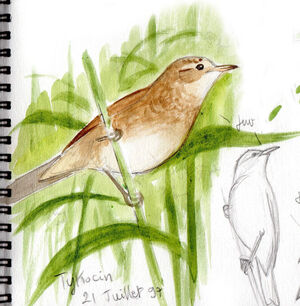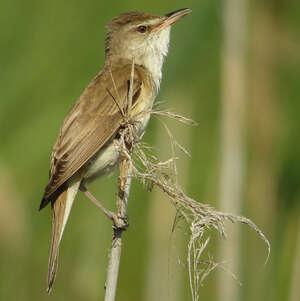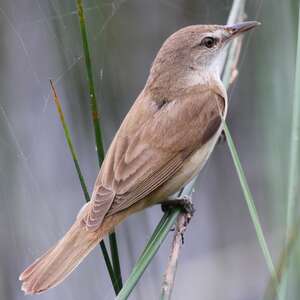Great Reed Warbler
Acrocephalus arundinaceus - Rousserolle turdoïde
Identification
The Great Reed Warbler is very similar to the Common Reed Warbler, only in size. It is the largest of all warblers. It looks like a 'magnum' version of the Common Reed Warbler, being one third bigger and twice as heavy - a fact that is clearly apparent in the field. The plumage and bare parts are virtually identical, providing very effective camouflage when in its preferred habitat of reed beds. Both species feed and forage in the same way. In addition to size, a surefire distinguishing factor is the much heavier and proportionate bill of the Great Reed Warbler compared to the Common Reed Warbler.
Subspecific information 2 subspecies
- Acrocephalus arundinaceus arundinaceus (Europe to n Iran and nw Arabia)
- Acrocephalus arundinaceus zarudnyi (se European Russia and n Iran to nw Mongolia and nw China)
Foreign names
- Rousserolle turdoïde,
- Carricero tordal,
- rouxinol-grande-dos-caniços,
- Drosselrohrsänger,
- nádirigó,
- Grote Karekiet,
- Cannareccione,
- trastsångare,
- Trostesanger,
- trsteniarik veľký,
- rákosník velký,
- Drosselrørsanger,
- rastaskerttunen,
- Grootrietsanger,
- balquer,
- Reyrsöngvari,
- trzciniak (zwyczajny),
- niedru strazds,
- rakar,
- Дроздовидная камышевка,
- ニシオオヨシキリ,
- 大苇莺,
- trastsångare,
- 西方大葦鶯,
Voice song and call
The song of the Great Reed Warbler, most often emitted from a dry reed stem of Phragmite, is distinct and allows for an immediate identification. Compared to that of other warblers, it is much more powerful, correlating to the bird's size, and is carried far. It is composed of expositions on a relatively slow rhythm and of varying tones. The cracking syllables alternate with others that are higher and shrill. The cries are also correlated with its size. The most frequent is a low and gruff rolling cry.
Habitat
The Great Reed Warbler is the one with the most restricted habitat of all the Warblers, namely exclusively reed beds. It occupies the reed beds bordering water bodies or water courses. Unlike the Reed Warbler which can occupy dry reed beds, the Great Reed Warbler needs permanent water. Despite its size, it is sometimes satisfied by small patches of reeds as well as small lines of reeds along ditches, drains or canals, provided they are in water.
Behaviour character trait
The first migrants are back in April in the south of the area, more likely in May in the north. From this moment on, the reed beds become animated with the territorial and sexual pursuits between adults, punctuated by rough vocal emissions.
Later, with the progress of nesting, the bird becomes more discreet, skilfully moving through the reeds. Only the cries of the young betray the presence of the families. A few low flights towards the nearby bushes can be observed. In summer, only a few cries of worry can be heard upon approach and very soon, from July-August, the birds start their post-nuptial migration, largely going unnoticed. Their stay will have lasted only 3-4 months.Dietfeeding habits
Reproduction nesting
Geographic range
The Great Reed Warbler has a wide distribution range stretching from Spain in the west to China and the Baltic States in the north and North Africa and Iraq in the south. Further east, a similar species, the Eastern Great Reed Warbler, takes its place. Despite this large range, only two subspecies are recognized. Europe is occupied by A. a. arundinaceus. The entire population winters in sub-Saharan Africa in wet and savannah areas.
Threats - protection
IUCN conservation status
concern
in the Wild
threatened
evaluated
The Great Reed Warbler is experiencing a decline in many places, such as France. However, tracking it in Lorraine has shown only significant fluctuations between years. It is evident that this great trans-Saharan migrant is affected by the prevailing conditions, especially the climate, both on its migratory paths and in its subsaharan wintering grounds and these are responsible, accompanied by mortality, for determining the species' demographics. The health of its breeding areas is the second most important factor, just as it has been shown for the Grasshopper Warbler.
Sources of information
- IOC World Bird List (v15.1), Gill, F and D Donsker (Eds). 2025-12-07.
Other sources of interest
 Specification sheet created on
25/07/2023 by Jean François
Specification sheet created on
25/07/2023 by Jean FrançoisTranslation by AI Oiseaux.net
© 1996-2025 Oiseaux.net
- Accipitriformes
- Aegotheliformes
- Anseriformes
- Apodiformes
- Apterygiformes
- Bucerotiformes
- Caprimulgiformes
- Cariamiformes
- Casuariiformes
- Charadriiformes
- Ciconiiformes
- Coliiformes
- Columbiformes
- Coraciiformes
- Cuculiformes
- Eurypygiformes
- Falconiformes
- Galliformes
- Gaviiformes
- Gruiformes
- Leptosomiformes
- Mesitornithiformes
- Musophagiformes
- Nyctibiiformes
- Opisthocomiformes
- Otidiformes
- Passeriformes
- Pelecaniformes
- Phaethontiformes
- Phoenicopteriformes
- Piciformes
- Podargiformes
- Podicipediformes
- Procellariiformes
- Psittaciformes
- Pterocliformes
- Rheiformes
- Sphenisciformes
- Steatornithiformes
- Strigiformes
- Struthioniformes
- Suliformes
- Tinamiformes
- Trogoniformes






























